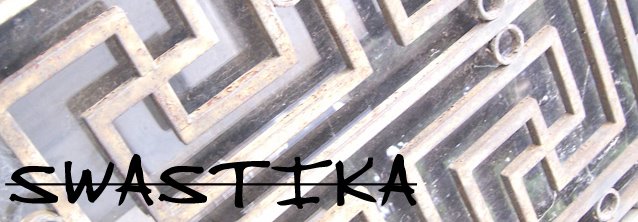Swastika Loeffler Bross.
Budapest, Kazinczy St - Dob St corner, orthodox synagogue and community house built by Béla Loeffler and Sándor Loeffler in 1911-13, in Art Nouveau style showing the influence of Vienna Secession and of Ödön Lechner's Hungarian Secession, also using Hungarian folk motifs and oriental motifs, though in a more simple and geometrical way. It also shows the transition towards Art Déco. View from Kazinczy street.
Foto: Elinor.
Swastika Neustadter Bross.
The Neustadter Brothers
The firm of Neustadters Brothers was established in 1852 by the brothers Louis W. and Henry Neustadter. The company was one of the earliest men’s clothing manufacturer and dealerships in San Francisco. They would become known for such clothing as their ‘’Standard’’ shirts brand and the ‘’Boss of the Road’’ overalls.
Swastika Huanghuazhen
Foto Zane
Huanghuazhen (literally "yellow-flower maze") is a maze formed of 1.2 metre-high embossed-brick walls covering an area of 89 by 59 metres. The total length of the walls is 1.6 kilometres. In its centre sits a European-style circular pavilion. The emperor is said to have sat in this pavilion to watch his concubines competing in a race with yellow lanterns through the labyrinth on the occasion of the Mid-Autumn Festival.
Foto: Zane
The Old Summer Palace, known in China as Yuan Ming Yuan (the Gardens of Perfect Brightness), and originally called the Imperial Gardens, was a complex of palaces and gardens in Beijing. It is located 8 kilometres (5.0 mi) northwest of the walls of the Imperial City, built in the 18th and early 19th century, where the emperors of the Qing Dynasty resided and handled government affairs (the Forbidden City was used for formal ceremonies).
Huanghuazhen (literally "yellow-flower maze") is a maze formed of 1.2 metre-high embossed-brick walls covering an area of 89 by 59 metres. The total length of the walls is 1.6 kilometres. In its centre sits a European-style circular pavilion. The emperor is said to have sat in this pavilion to watch his concubines competing in a race with yellow lanterns through the labyrinth on the occasion of the Mid-Autumn Festival.
Foto: Zane
The Old Summer Palace, known in China as Yuan Ming Yuan (the Gardens of Perfect Brightness), and originally called the Imperial Gardens, was a complex of palaces and gardens in Beijing. It is located 8 kilometres (5.0 mi) northwest of the walls of the Imperial City, built in the 18th and early 19th century, where the emperors of the Qing Dynasty resided and handled government affairs (the Forbidden City was used for formal ceremonies).
Swastika Christmas Bread
Božićni kruh (“Christmas bread”), Livno (western Bosnia and Herzegovina), 1970. This particular bread was baked on the occasion of the winter solstice, when the sun reached his lowest position and prepared to be born again
Swastika Skiing Suit
Vicky from Original Sin, Antwerp took this foto ages ago so she can't tell us from where or what it is.
Swastika Bokeh
Dough Knisely writes about his foto: The Buddha seems so chill here. Perhaps that is the point? #Bokehliscious.
Swastika Swinging Arns
Swinging Arms is a new online shop who have also payable things like stickers and other stuff check it out!
Swastika Sensō-ji
Jos took this foto in Sensō-ji, is an ancient Buddhist temple located in Asakusa, Taitō, Tokyo, Japan. It is Tokyo's oldest temple, and one of its most significant. Formerly associated with the Tendai sect, it became independent after World War II.
Swastika Waterpipe
Martin writes about his foto: I only just this week noticed the symbol on the mains pipes outside my apartment in Sydney, Australia after living there for over a year!
Swastika Coral
Handpoke tool was made by Guy Le Tatooer. Details: Black and red coral !!! Property . Black coral : Protect against the negativity. Protective stone of the travelers. Red coral : Warm, animates and stimulates the blood circulation . Handmade for Liam Sparkes in Bangkok .
Swastika FreeMason
Amazing Discoveries says about his foto: At the Oklahoma Masonic Lodge. Notice the Swastikas and the dragon and serpent images, and winged solar disk.
Swastika Manichaean
A friend from Bosnia send me this mail: I come from Bosnia and here we have maybe oldest depiction of swastika in whole Europe... they are on some medieval tombstones, and are at least 700 years old... those tombstones belonged to members of today non-existing Manichean Bosnian church. i dont know much about them, not because i dont want, but because theres no way to find out... our history is re-written many times by austo-hungarian empire, communist regime, vatican and others, its hard to know what is truth and what is lie.
This info Swastikablog found on Wikipedia: Manichaeism as a syncretistic form of oriental Christianity was quickly successful and spread far through the Aramaic-Syriac speaking regions, it thrived between the third and seventh centuries, and at its height was one of the most widespread religions in the world. Manichaean churches and scriptures existed as far east as China and as far west as the Roman Empire. It was widespread among the legions of the Roman Empire, who considered it a soldier's religion, and it was briefly the main rival to Christianity in the competition to replace classical paganism. Manichaeism survived longer in the East than in the West, and it appears to have finally faded away after the 14th century in southern China, contemporary to the decline in China of the Church of the East
Swastika Galleta
Ismael, Mexico, tells me he had a good sign in his breakfast to start the day, was a pleasant surprise.
Subscribe to:
Comments (Atom)


































